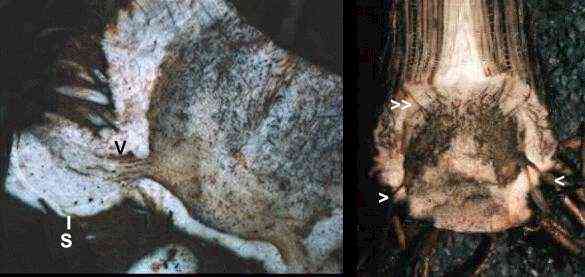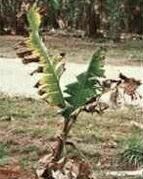Vascular wilt diseases are caused by pathogenic fungi or bacteria that enter the water-conducting xylem vessels of a plant, then proliferate within the vessels, causing water blockage. The typical symptoms include wilting and death of the leaves, followed often by death or serious impairment of the whole plant. As a group, therefore, the vascular wilts are among the most devastating plant diseases. There are several interesting features of these diseases. For example, the blockage of the xylem vessels is not necessarily caused by the pathogens themselves but often by the host reactions to invasion - the production of gel-like materials which serve as potential barriers to spread of the pathogens in the vessels. In addition, some of the symptoms, such as the common yellowing of the leaves and the loss of control of stomatal function, may are caused by toxins produced by the pathogens. But perhaps the most interesting point is that the pathogens have only a weak ability to invade living plant tissues; instead, they grow in the nutrient-poor conditions of the water-conducting vessels, and they only grow into the rest of the plant when it has been weakened or killed by water stress. On thhis page we consider one of the most important examples of these diseases - Panama disease of bananas, caused by the fungus Fusarium oxysporum. On a further page, we consider another example - Dutch elm disease, caused by the fungus Ophiostoma ulmi (or O. novo-ulmi). Panama disease: a classic vascular wilt Panama disease of bananas ranks as one of the most important diseases in agricultural history. At one stage in the 1940s and 1950s, this disease threatened to wipe out the banana production industry in Central America and the Caribbean, with devastating effects on the local economies. The situation was saved only by the fortuitous discovery of a resistant type of banana plant which was not in commercial production. Over a period of years, all the existing plantations of the susceptible cultivar (the 'Gros Michel' type) were replaced by plantings of the new 'Cavendish-type' cultivar, and this cultivar has remained resistant to the present day. Nevertheless, the problem still threatens because the Cavendish-type cultivars are becoming heavily diseased in the sub-tropical regions of South Africa, Australia and the Canary Islands. These regions are outside the natural range for banana production because the winter temperatures are low enough to stop the plants growing. This factor may exacerbate the disease, but there is also evidence that a new and more virulent 'race' of the pathogen is present in these countries. If it should spread and cause disease in the tropics then the world banana trade would be threatened once again. |
||||
 Cavendish-type banana plants showing severe Panama disease in South Africa |
||||
The disease Panama disease is a classic vascular wilt disease, in which a fungus, Fusarium oxysporum, gains entry to the water-conducting xylem vessels, then produces spores that are carried upwards in the water stream.The upwards spread is blocked temporarily when the spores lodge on the perforated vessel end walls that occur at intervals up the plant. But then the spores germinate and the hyphae grow through the perforations to produce a further batch of spores. The whole xylem system is colonised rapidly, leading to the characteristic symptoms. The older leaves turn yellow at the margins then die progressively towards the midrib, and the dead leaves hang down as a skirt around the stem. Eventually the whole shoot is killed, but meanwhile it has produced apparently healthy 'suckers' from the underground rhizome (arrowheads in the right-hand picture). These will grow in the following season but will also succumb to the disease. There is still debate about the role of fungal toxins in vascular wilt diseases. F. oxysporum is known to produce the toxin fusaric acid in culture filtrates, but most of the disease symptoms seem to be caused by the plant responses to infection. In particular, there is a rapid accumulation of vascular gels which become impregnated with phenolic materials, apparently as an attempt to contain the fungus (see images below). If the initial infection is light, and the plant responds rapidly, then the disease can be localised to a few infected vessels. Conversely, if the initial infection is severe and the plant response is slow then the plant dies. At this stage the fungus grows from the xylem into the surrounding, dead fleshy tissues and produces many resting spores (chlamydospores) by the deposition of a thick, melanised wall around individual hyphal compartments. These chlamydospores are returned to the soil when the plant tissues decay. They can survive for many years in soil, and are almost impossible to eradicate. Even if bananas are planted 20 years later they can succumb rapidly to infection. |
||||
 |
||||
The image on the right is a longitudinal section through the base of a banana plant, showing clearly how the fungus has entered the rhizome from several roots (arrowheads) and caused massive discoloration and blockage of xylem vessels. From the rhizome the infection has spread upwards into the leaf sheaths (a discoloured vascular trace is marked by a double arrowhead). One of the commonest means of disease spread is through infected planting material. Cultivated bananas do not produce seeds because they are sterile triploids, so they are propagated by removing suckers from established plants. The danger of this practice is illustrated in the left-hand image, where a parent rhizome has been cut to show vascular infection (V) spreading into the base of a young sucker (S). In the last 15 years there has been a large development of sterile, meristem culture facilities to supply young plantlets free from Panama infection and the damaging bunchy top virus. |
||||
Ecology of vascular wilt fusaria Fusarium oxysporum is a common soil fungus, found in almost all parts of the world as a harmless coloniser of root surfaces or a weak invader of the root cortex of many plants. However, in addition to this background population (or perhaps as an integral component of it) there are over 80 known strains that show specific pathogenicity to particular crops, causing the vascular wilt diseases. The strains that specifically affect banana are termed F. oxysporum f. sp. cubense, those that affect tomato are F. oxysporum f. sp. lycopersici, those on peas are F. oxysporum f. sp. pisi, and so on. They cannot be distinguished except by pathogenicity tests, and even the pathogenic strains can grow as harmless root colonisers in some conditions, while causing devastating diseases in other circumstances. Much needs to be learned about the ecology of these pathogens and their relationships to the general soil population of F. oxysporum. [The term 'f. sp.' is an abbreviation of forma specialis, meaning 'special form'. The plural is formae speciales (ff. spp.). The term 'pathovar' would be much simpler!] |
||||
| Further reading: RC Ploetz (Ed.), 1990. Fusarium Wilt of Banana. APS Press, St Paul. |
||||
